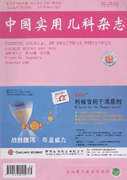|
|
Clinical analysis of polyarticular and oligoarticular juvenile idiopathic arthritis.
2013, 28(5):
361-365.
Abstract:Objective To investigate characteristics of clinical manifestation and therapy in children with oligoarticular and polyarticular juvenile idiopathic arthritis (JIA). Methods The medical records of 89 children with polyarticular or oligoarticular JIA in Children's Hospital of Chongqing Medical University from 2006 to 2011 were retrospectively reviewed. Results Totally 42 boys and 47 girls(M∶F ratio,1∶1.1) were included in the study, nearly a half (48.31%) were older than the age of 8 years.There were 37 cases of oligoarticular JIA,no case of extended oligoarthritis,and 52 cases of polyarticular JIA, consisting of 10 cases of rheumatoid factor positive (RF+) and 42 cases of rheumatoid factor negative(RF-). Oligoarticular and polyarticular JIA were mainly characterized with joint symptoms, while systemic and extra-articular symptoms were rare. Oligoarthritis predominantly involved legs, with the knee joints(28.00%) mostly affected, followed by the ankles (21.33%) and hips(17.33%). Polyarthritis also affected the large joints at onset, knees (20.00%) and ankles(18.50%), but usually in association with small joints of the hands(18.00%) and wrist joints(16.00%). Chronic uvitis was recognized in 4 cases (4.50%), without ANA positive. Laboratory investigations were just used to help differential diagnosis. There was a high positive rate of HLA-B27(27.78%). Sixty-one patients were treated with a combination therapy of NSAIDs and DMARDs. For the 28 refractory cases, the treatment with tumor necrosis factor receptor-antibody fusion protein was effective without adverse reaction. Conclusion Patients suffering from polyarthritis are more than those from oligoarthritis, which both mostly affect the school-age children. The females with polyarthritis are significantly more than males.There is a high positive rate of HLA-B27, and low rate of antinuclear antibody and occurrence of iridocyclitis. DAS28 is a suitable criteria to evaluate clinical response in JIA. Methotrexate has been proved safe and effective for polyarthritis. Tumor necrosis factor receptor - antibody fusion protein is safe and effective to relieve the joint symptom, which helps to improve the prognosis of JIA.
|

